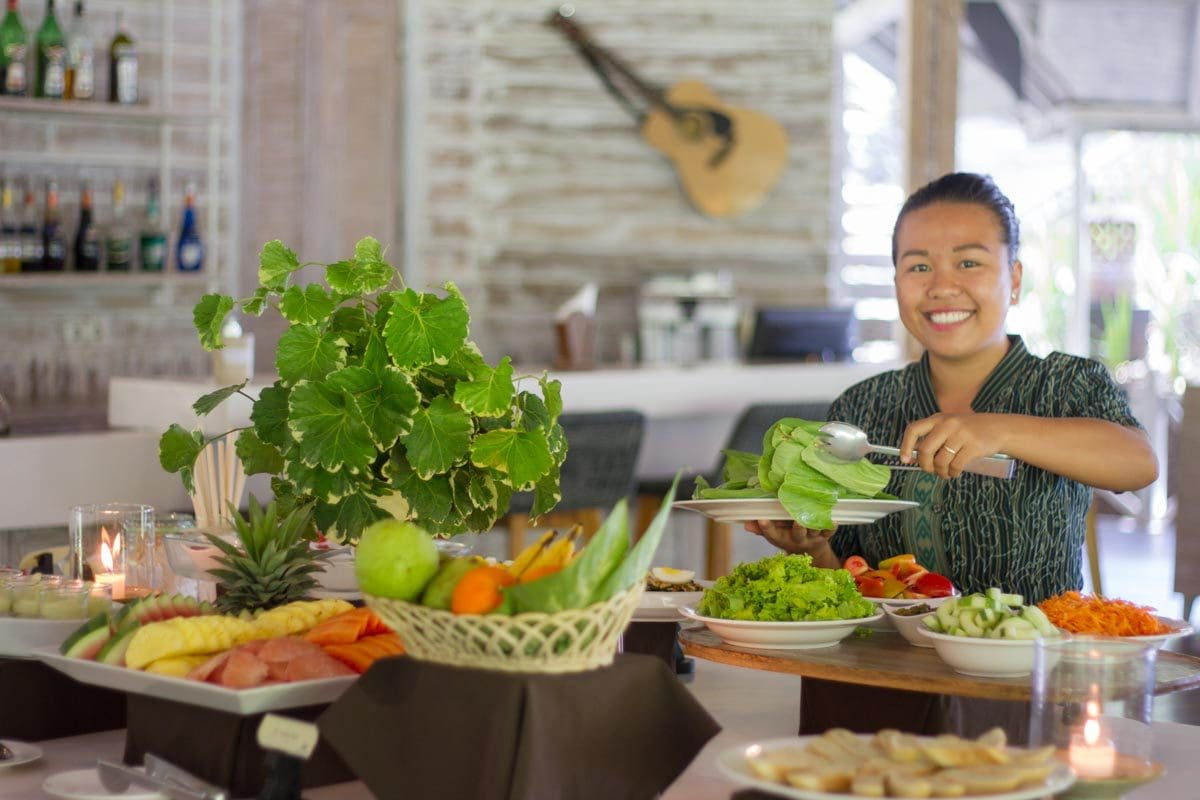
Ayam Buluh Recipe – A Taste of Lembeh
Indonesian food is one of the most vibrant and colorful cuisines in the world, full of traditional herbs, spices and aromatics. With over 17,000 islands in the Indonesian Archipelago the cuisine is as varied as the country itself and traditional classics are steeped in culture and history.
Indonesia’s humid climate and fertile soil provides ideal growing conditions for a wide range of spices including lemongrass, cloves, ginger, turmeric, nutmeg, cinnamon, coriander, chili peppers, kaffir lime leaves and of course, coconut – all of which are regularly used in local dishes. Manadonese food reflects the culture of the area and features many fragrant soups, meat and fish dishes which utilise aromatics grown here in North Sulawesi.
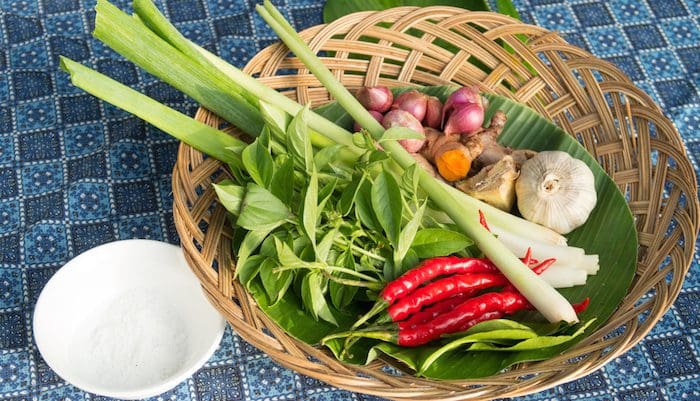
Lembeh Resort’s Ayam Buluh
One of our favorite Manadonese dishes is “Ayam Buluh” which literally translates to “bamboo chicken”. This delicious dish incorporates a mix of local herbs and spices and is baked encased in a bamboo pipe from which it is later served. If you’re missing a taste of Indonesia you can find our authentic “Ayam Buluh” recipe here and relive your Lembeh Resort dining experiences from home, it’s perfect to enjoy with sambal goreng. (We’ve incorporated an aluminum foil and oven-bake option just in case you can’t source bamboo!) We hope you enjoy being transported back to us through this little taste of Lembeh Resort.
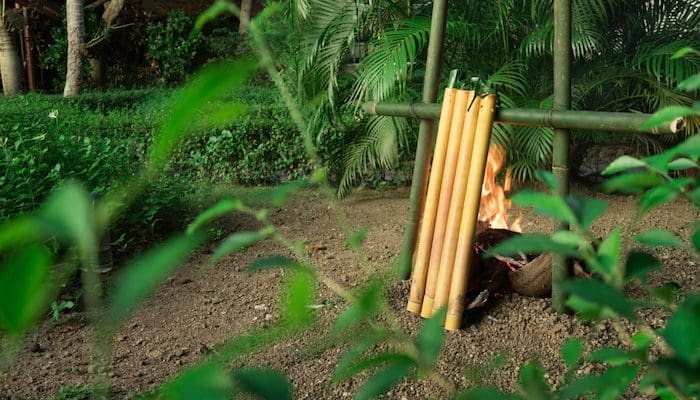
Lembeh Resort’s Ayam Buluh Recipe
Ingredients:
- 5 freshly cut and rinsed bamboo pipe (20cm long/6cm diameter) OR 5 sheets of
aluminum foil 20cmx20cm - 10 turmeric leaves
- 800g chicken thighs (de-boned and skin removed)
- 50g lemon basil
- 6 kaffir lime leaves (often called makrut lime leaves)
- 2 stalks of fresh lemongrass (lower tender parts only, discard the woody top)
- 6 spring onions
Spice-paste:
- 20 large very mild red chili peppers
- 8 cloves of small shallots
- 3 cloves of garlic
- Thumb size piece of fresh ginger
- 2 tsp salt
- 1 tsp red palm nectar OR substitute with 1 tsp of brown sugar and 1 tsp water
Cooking method:
- Cut the chicken thighs into cubes of 3x3cm, use chicken thighs for this recipe as they
withstand slow cooking better than breast meat. - Slice the lemon basil, kaffir lime leaves, and lemongrass as thinly as possible. Cut the
spring onions diagonally into small pieces of 2-3cm. - Grind the spice paste ingredients in a heavy mortar until a uniform paste is achieved.
- Please note that the chili peppers are used for flavor not spiciness. The chili peppers
should be mild enough that you can eat them raw without your mouth catching fire! - Mix the chicken cubes, the fresh herbs, and the spice paste. Cover and chill for 2-3
hours to allow the flavors to penetrate the meat. - Start a small amount of charcoal in your BBQ or preheat oven to 150 degrees C.
- Stuff the cleaned bamboo pipes with the chicken and crumble up a turmeric leaf to
close each of the open ends. If available, a plug made of the shell of a young
coconut can be pushed into the opening – this seals the pipe more efficiently and
keeps all flavors trapped in the bamboo pipe. If using an aluminum foil spoon the
chicken mixture into a line down the centre of the foil and roll tightly to form cylinder-shaped parcels, folding over at the ends to seal. - Cook over embers on the BBQ for 1.5 hours (or in the oven). When ready, cut open
the bamboo pipes with a meat cleaver and serve directly in the bamboo with steamed
water-spinach, white rice, and of course a good homemade Dabu Dabu Goreng. If
using foil, simply unwrap, serve, and enjoy!
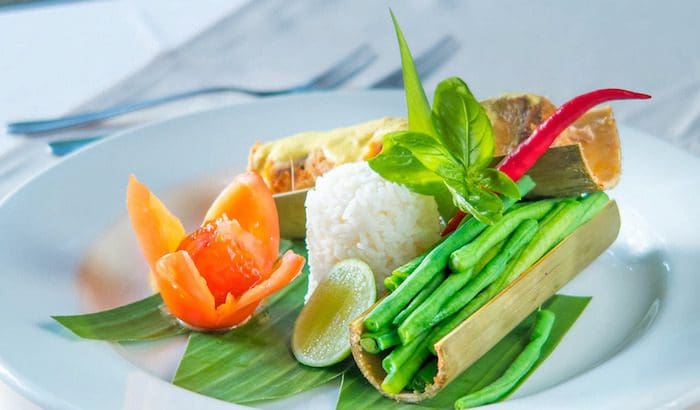
Indonesian food is known for having a “bit of a kick” to it but the majority of dishes use herbs and aromats to create complex flavors rather than heat. The spice mainly comes from condiments and “sambal” (Indonesian chili sauce) which is added once the dish has been served such as traditional Soto Ayam. Of course, we have a number of different sambals for you to try but if spicy food is not to your liking you can enjoy beautiful, flavorful dishes without it.
At Lembeh Resort we use only fresh, local produce and pride ourselves on giving guests the opportunity to experience the true flavor of Indonesia. Many of our herbs are grown in our very own herb garden here in the resort – take a moment to have a look around while you are here. It’s not just the produce we use which makes our dishes special, we also prepare our dishes using traditional cooking methods which date back hundreds of years.
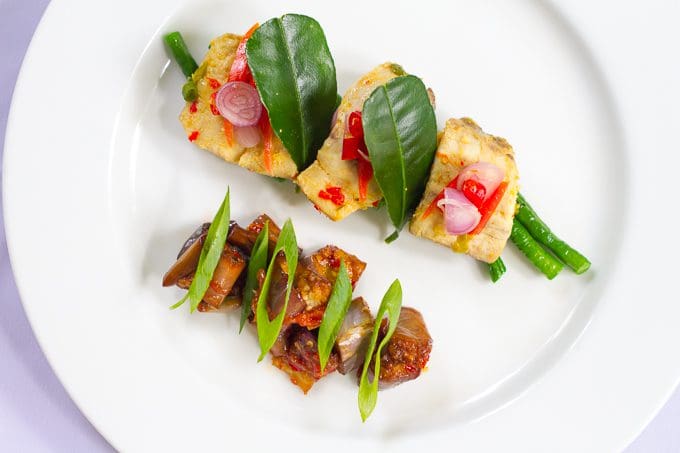
Our satay is barbecued over coconut husks rather than charcoal to give it the authentic flavor it is famous for and our pepes ikan (locally sourced fish) is cooked in a banana leaf to ensure depth of flavor. At Lembeh Resort we never use artificial flavorings so while you are enjoying a taste of Asia you can rest assured that you’re eating fresh, healthy, and, wherever possible, organically grown produce.
For those who enjoy Western cuisine our experienced chefs also prepare anything from delicate handmade pastas to fresh seafood, homemade breads, and a large variety of delectable desserts.
DIVE AND STAY AT LEMBEH RESORT
Are you ready to dive into Lembeh and taste the Ayam Buluh? Stay at Lembeh Resort and enjoy the wonders of the Strait in comfortable accommodation with a touch of luxury. Our secluded location on Lembeh Island, combined with our exclusive service and exquisite dining make Lembeh Resort a wonderful home away from home in North Sulawesi.
Our professional dive guides are marine biology and trained underwater photography (with PADI or SSI certified), and we are the only dive resort in Lembeh with on-site marine biologists, photo pro and Backscatter Authorized Photo Center.
Explore Lembeh Resort rates and secure your extraordinary dive adventure today! For more information or to make a reservation contact us at: reservations@LembehResort.com.
